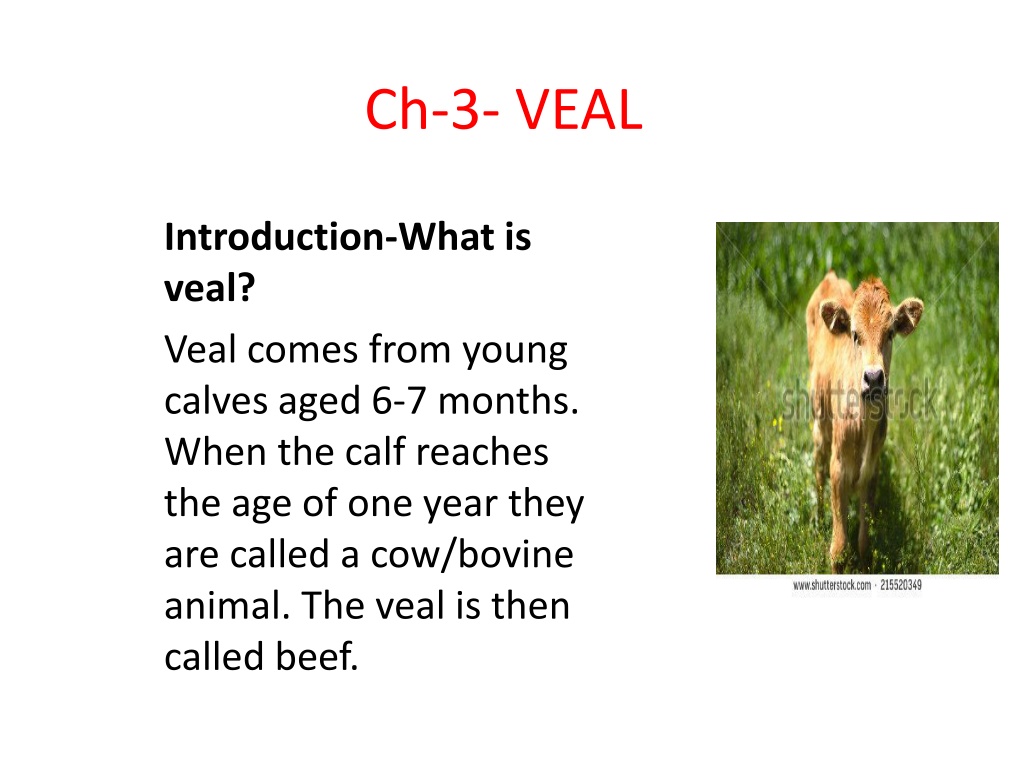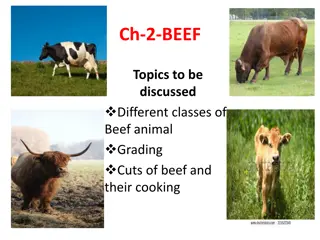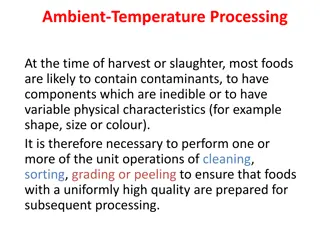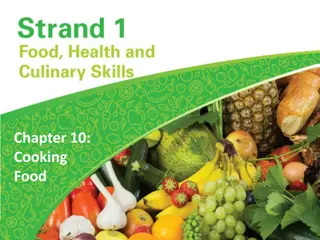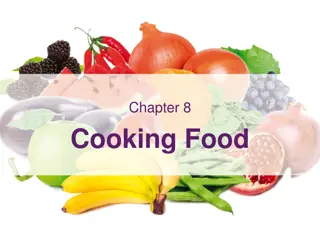Veal: Types, Characteristics, Grading, and Cooking Methods
Veal is a tender meat sourced from young calves aged 6-7 months. It has a light color, fine texture, and smooth taste. Learn about different types of veal such as Bob Veal and Special-Fed Veal, as well as the grading system for veal carcasses. Discover the various cuts of veal and explore recommended cooking methods, including dry heat methods for tender cuts and moist heat methods for less tender cuts. Get cooking tips and temperature guidelines for preparing veal dishes.
Download Presentation

Please find below an Image/Link to download the presentation.
The content on the website is provided AS IS for your information and personal use only. It may not be sold, licensed, or shared on other websites without obtaining consent from the author.If you encounter any issues during the download, it is possible that the publisher has removed the file from their server.
You are allowed to download the files provided on this website for personal or commercial use, subject to the condition that they are used lawfully. All files are the property of their respective owners.
The content on the website is provided AS IS for your information and personal use only. It may not be sold, licensed, or shared on other websites without obtaining consent from the author.
E N D
Presentation Transcript
Ch-3- VEAL Introduction-What is veal? Veal comes from young calves aged 6-7 months. When the calf reaches the age of one year they are called a cow/bovine animal. The veal is then called beef.
Characteristics Veal has light colour, a fine texture, a smooth taste and is tenderer. Young veal is generally excluded from market; that from an animal about 2 months old is considered best. The meat is much paler than beef, and shows no mottling of the lean with fat. It should be pinkish and fine-grained.
Types of Veal Bob Veal: About 15% of veal calves are marketed up to 3 weeks of age or at a weight of 150 pounds. These are called Bob Calves. Special-Fed Veal: Special, milk-fed and formula fed veal calves usually are fed nutritionally balanced milk or soy based diets. These specially controlled diets contain iron and 40 other essential nutrients, including amino acids, carbohydrates, fats, minerals and vitamins. The majority of veal calves are "special-fed."
Grading Veal and calf carcasses are graded on a composite evaluation of two general grade factors: conformation (proportion of lean, fat, and bone in carcass); and quality of the lean. There are 5 grades for veal: prime, choice, good, standard, utility.
Dissection/Cuts of veal 1. Neck. 2. Chuck. 3. Shoulder. 4. Fore shank. 5. Breast. 6. Ribs. 7. Loin. 8. Flank. 9. Leg. 10. Hind shank.
Cooking Methods Dry Heat Methods- Tender Cuts 1. Roasting 2. Broiling 3. Pan-broiling 4. Pan-frying 5. Stir-frying (Tender cuts including leg, cutlets, veal patties, and rib or loin chops)
Contd. Moist Heat Methods -Less Tender cuts 1. Braising 2. Cooking in a Liquid (simmering/stewing) (Less tender cuts, such as cross cut shanks, stew meat, round steak and breast of veal)
Cooking Tips/Temperature Cook all organ or variety meats (such as heart, kidney, liver, and tongue) to 160 F. Cook all raw veal steaks, chops, and roasts to a minimum internal temperature of 145 F. For safety and quality, allow meat to rest for at least 3 minutes before carving or consuming.
Thank you!!! For your kind listening Chapter-3 is completed Bye take care
